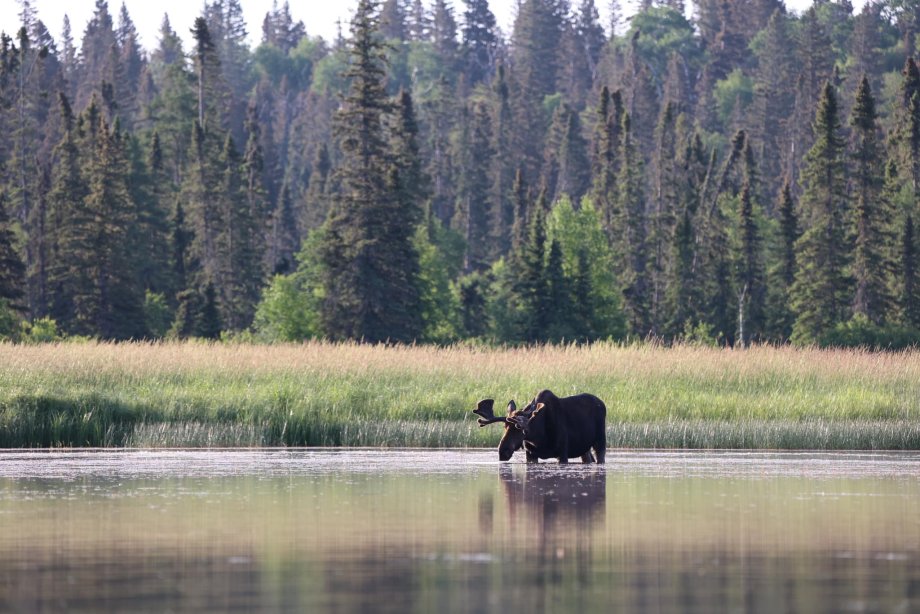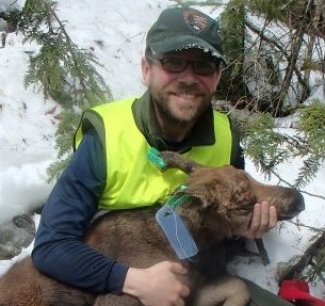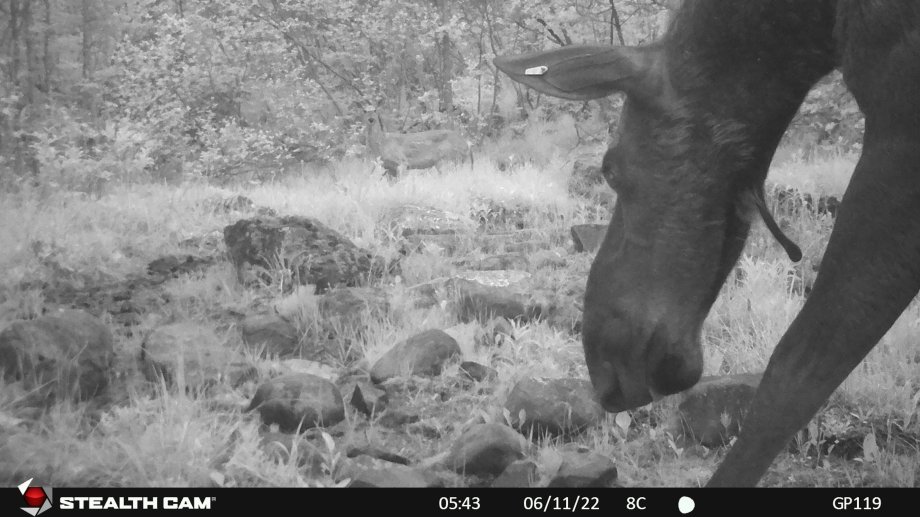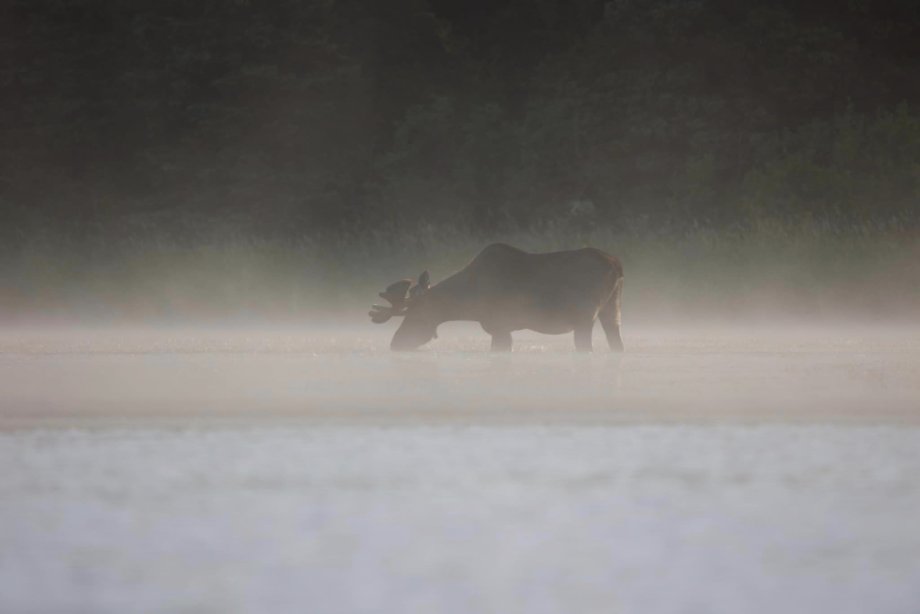
Research conducted by William Severud, a South Dakota State University assistant professor, is providing new insights into brainworm, one of the leading causes behind Minnesota's moose population decline.
For many years, the Grant Portage Band of Lake Superior Chippewa — a federally recognized tribe — has relied on moose (Alces alces) as a traditional source of subsistence and view the animal as a "cultural keystone." Through the 1854 Treaty, the Anishinaabe people of Grand Portage have a right to food sovereignty through subsistence hunting and fishing. They historically hunt for a handful of animals each fall.
But over the past several years, the harvest limit has dwindled, reflecting a moose population in sharp decline.

The population trends paint a decidedly bleak picture. In the 1980s, Minnesota had two distinct moose populations: one in the northeast corner of the state and one in the northwest. By the turn of the century, the northwest population, which at one time had a population estimate at over 4,000 animals, was reduced to less than 100. High adult mortality rates and low pregnancy rates were the primary culprits.
The northeast population continued to be strong throughout the early 2000s, and in 2009, the population was estimated to be at or near 8,000. Then, the population sharply declined. Now, the estimated population sits at around 3,500 moose concentrated primarily in the Arrowhead Region of northern Minnesota. The population, according to the researchers and the Minnesota Department of Natural Resources has stabilized, but what were the factors that led to this sharp decline?
William Severud, an assistant professor in South Dakota State University's Department of Natural Resource Management, has been conducting research on Minnesota's moose population for over a decade. Moose are being threatened on multiple fronts, Severud explained, and the factors behind their decline are complex.
"The root cause behind the decline is multifaceted," Severud said. "One of the biggest — and most concerning — culprits is parasites."
Brainworm
Known as Parelaphostrongylus tenuis but more commonly referred to as "brainworm," this parasite is responsible for approximately 25-30% of adult moose deaths. The parasite, which infects slugs and snails from deer feces, is ingested by foraging animals, like moose. Larvae then spread, which in turn makes the animal become weak and confused, resulting in blindness, an inability to stand and various other neurological pathologies.
During the winter, when researchers fly over the Minnesota forest surveying the landscape and looking for moose, they will sometimes find circles of moose tracks in the snow — a signal that the animal is at the later stage of infection. If the animal doesn't "naturally" die from the parasite, predators, like wolves and black bears, are quick to vanquish the weakened moose.
"We've known for a long time that brainworm has been one of the biggest factors in the population decline," Severud said. "The biggest mystery has always been, how are they catching it?"
Brainworm is a parasite that uses white-tailed deer as a natural host. While brainworm has a devastating effect on moose, deer are seemingly unaffected. As human development in northern Minnesota opened the forests to white-tailed deer, they began overlapping in what was primarily moose territory. Still, moose are solitary creatures and generally avoid interactions with other animals, researchers thought. How were so many becoming infected by this devastating parasite?
This has been a mystery to researchers, Severud said. To become infected with brainworm, a moose or deer must eat a gastropod (slug or snail) that has the parasite inside it. But, as Severud explained, when researchers go out into the field to collect gastropods, very few have the parasite present.
"Some people have thought that when the snails and slugs catch the parasite, they might climb the 'vegetation ladder' and become more vulnerable to being eaten," Severud said. "Sometimes parasites can influence behavior, but there hasn't been any evidence of that occurring. It might be that deer and moose are seeking out these gastropods to eat as a protein source, but they are very tiny — some of them are as small as a pinhead."
It's possible that moose are consuming a very large quantity of these snails and slugs, Severud said. Another possibility is that deer and moose are congregating together in specific, discrete spots in the forest. This theory was the basis of research conducted by Severud and his colleagues.
These discrete locations, referred to as "mineral licks" by researchers, are permanently wetted areas that contain various minerals and are often visited by both deer and moose to drink water and consume soil. Because deer are present, so is deer fecal matter which often contains the deadly parasite. The wetted areas are also an ideal breeding ground for these gastropods. All-in-all, these locations are a perfect combination for this parasite to transfer from deer to moose.
To support this theory, the researchers placed trail cameras at several mineral lick sites. The cameras not only captured evidence of deer and moose at the same mineral lick, they found evidence of deer and moose at mineral licks simultaneously.

While more research needs to be done to confirm the presence of brainworm in the gastropods found in the mineral lick areas, the evidence of both deer and moose congregating simultaneously provides enormous insight into why so many moose are falling victim to brainworm.
Wolves
Brainworm is not the only factor that has accounted for a 50% decline in Minnesota's moose population. Predators are also responsible for a large percentage of all moose mortalities. Wolves are of particular concern to researchers primarily due to the density of them in the Arrowhead Region, but, according to Severud, an increase in wolves has not caused a decrease in the moose population.
The real issue moose have with wolves can be traced back to deer. In Minnesota, there are ongoing efforts to restore moose habitats. Habitats that are good for moose are also good for deer.
"When there's more deer on the landscape, there can be more wolves," Severud said. "That can then lead to more moose calves being taken by the wolf population. That is what we refer to as apparent competition. It's like deer and moose are competing with each other through a shared predator."
A higher deer population greatly contributes to a higher wolf population. Minnesota is home to the highest gray wolf population in all of the Lower 48 states, sitting at approximately 4,000.
"If there was no deer and only moose, the wolf population would be much smaller," Severud added.
Ticks
Warmer winters and longer summers in northern Minnesota — a result of a changing climate — are allowing winter ticks to thrive. This is having devastating consequences on the moose population. What these bloodsucking parasites lack in size is made up for in sheer numbers. As many as 100,000 winter ticks can be found on a single moose.
"They start as little larval ticks in the fall and then huge clumps of them — like thousands of little larval ticks — attach to a moose," Severud said. "They feed on them, turn into a nymph, feed on them again and then eventually turn into adult ticks. They stay on the moose all winter long."
By burrowing deep underneath the moose's warm, thick coat, the ticks are able to survive throughout the harsh winter. Then, in the spring, they drop off and lay eggs in the soil. The process repeats itself. If there is snow on the ground, a lot of the eggs will die off. But when it's an early spring or a particularly warm winter, tick outbreaks can occur. This is more or less a death sentence for moose calves, who are particularly vulnerable to winter ticks. A study conducted in New Hampshire — home to a large moose population — found that 70% of calves were dying over a three-year period. Most of the deaths could be traced back to tick infestations.
Alongside brainworm, ticks are one of the leading moose-killers and are primarily responsible for killing off large percentages of calves as they approach their first birthday.

Solutions
In an interesting — and counterintuitive — turn, a solution to some of these challenges may come from cutting down trees in Minnesota's old-growth forests. Analysis done by Severud and other researchers theorize that forest management techniques may be beneficial in limiting gastropods, which in turn would limit brainworm. Research conducted in and around Voyageurs National Park in northern Minnesota shows that forest management techniques just outside of the park limit the number of gastropods. Inside the park, where there have been little to no forest management treatments, the density of gastropods is much higher.
“Any sort of forest management treatment might decrease the gastropod numbers, and that might lead to a decrease in the number of infected gastropods on the landscape," Severud said.
In the early part of the 21st century, northern Minnesota had two major fires: the Ham Lake Fire in 2007 and the Pagami Creek Fire in 2011. Both, initially, had devastating effects on the old-growth boreal forests that proliferate the area. It wasn't until a few years later that researchers discovered a "positive" from the fires: an increase in moose abundance in the afflicted areas, the only place in Minnesota where the moose population actually increased.
Forest management treatments, including prescribed (and unprescribed) burns, benefit moose directly, as they prefer to feed on "new-growth" areas following a fire or even logging activity. Forest management treatments could play a similar role in creating preferred feeding grounds for moose.
In a world where while-tailed deer and moose habitats overlap, forest management treatments could be a crucial tool in rebuilding the moose population.
As for the immediate future of the moose population, researchers will continue to pinpoint the underlying cause of this drastic decline. While more research is needed, understanding exactly how these majestic animals are falling victim to parasites will help direct scientists and policymakers to tangible solutions to protect this population for generations to come.
Severud collaborated with Todd Kautz and Jerrold Belant, a post-doctoral fellow and a faculty member from Michigan State University's Department of Fisheries and Wildlife, and Seth Moore, director of biology and environment at Grand Portage Band of Chippewa, for the research on mineral licks. Funding for this work was provided by the South Dakota Agricultural Experiment Station at SDSU and the Boone and Crockett Program at MSU, as well as a United States Fish and Wildlife Service Tribal Wildlife Grant and in-kind contributions, resulting from a long-term ecosystem health research program led by the Grand Portage Band of Lake Superior Chippewa and the University of Minnesota.
- Contact:
- Telephone number: 605-688-6161
Republishing
You may republish SDSU News Center articles for free, online or in print. Questions? Contact us at sdsu.news@sdstate.edu or 605-688-6161.

